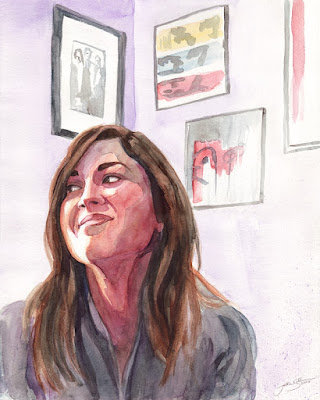Whenever we look at something we automatically bring it into focus. It's a survival mechanism, and therefore difficult to override, but when we're painting it's important to be able to choose what is in focus and what is not. If everything has distinct edges the painting can be brittle and staccato. The hard edges tend to compete with each other for attention, shattering the repose of the scene.
This painting would benefit from fewer hard edges. Those dark brown shapes in the background are threatening to come loose and rush forward. The clouds, too, are a little too assertive.
Choosing where to have soft and where hard edges is a very important part of making a cohesive watercolor. It's much too powerful a tool to ignore.
The edges in this Eastern Washington scene are all deliberately made hard or soft according to the job each shape plays in the big picture. Notice that the top of the big fir is hard, while the rest of the tree is soft. Why is that, do you suppose?
To decide where to use hard edges in a new painting, it helps to make a quick study that has none at all. Zero hard edges. Then you can use the study to decide where you really need hard edges. To select the most important places to opt for sharp focus, try giving yourself a ration of, say, three spots. This forces you to look at the study with an eye toward how to make good use of hard edges without overloading the painting. If three is not enough, add more, but one at a time, with detachment. Let the painting tell you where another is needed, rather than the scene or the photo.
To give this a try, you'll need to soak your paper for a few minutes. Put a 1/4 sheet in the sink or tub, in cool, not hot water. While it's soaking, wet the board or table where you plan to place the paper for painting. Now lift the sheet out of the water, in and let it drip a while. Then flatten it onto the wet surface. It will stay wet much longer than if you had just wet one side with a brush, but not forever, so move right along. Block in the major shapes with a layer of their palest color. The water that is already on the paper is enough for the whole job, so keep the brush pretty dry. Adding more water will make puddles on the page, inviting the shapes to wander too much.
As you move on to the middle value shapes the paint on your brush can be thicker than the first layer. When you get to the darks, it can be even thicker. Remember, as soon as the brush touches the wet paper you are adding the water that is already there to the brush. If you see a hard edge, stop painting.
You can dry the paper thoroughly and re-wet the area you want to work on with a single stroke of a large brush. Going back and forth when re-wetting will loosen the earlier layers and make a mess.
This is not an easy task. It requires a lot of concentration and a little speed. Don't forget that you can rewet a spot once the area is thoroughly dry, so no need to panic.
Remember, it's easier to add a hard edge than to take one away, and it's much easier to soften an edge while it's still wet than after it has dried.
Here are a couple of candidates:


















































